Bactria–Margiana Archaeological Complex
The Bactria–Margiana Archaeological Complex (short BMAC), also known as the Oxus civilization, is the modern archaeological designation for a Bronze Age civilization of Central Asia, dated to c. 2400–1900 BC in its urban phase or Integration Era,[1] located in present-day northern Afghanistan, eastern Turkmenistan, southern Uzbekistan and western Tajikistan, centred on the upper Amu Darya (Oxus River) in Bactria, and at Murghab river delta in Margiana. Its sites were discovered and named by the Soviet archaeologist Viktor Sarianidi (1976). Bactria was the Greek name for the area of Bactra (modern Balkh), in what is now northern Afghanistan, and Margiana was the Greek name for the Persian satrapy of Marguš, the capital of which was Merv, in modern-day southeastern Turkmenistan.
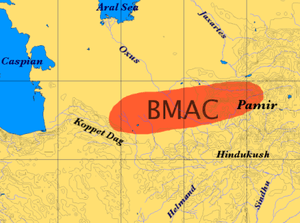
| Part of a series on |
| Indo-European topics |
|---|
 |
|
|
Philology
|
|
Origins |
|
Archaeology Pontic Steppe
Caucasus East Asia Eastern Europe Northern Europe Pontic Steppe Northern/Eastern Steppe Europe
South Asia Steppe Europe Caucasus India |
|
Peoples and societies Indo-Aryans Iranians
East Asia Europe East Asia Europe
Indo-Aryan Iranian
|
|
Religion and mythology
Indo-Aryan Iranian Others Europe
|
|

Sarianidi's excavations from the late 1970s onward revealed numerous monumental structures in many sites, fortified by impressive walls and gates. Reports on the BMAC were mostly confined to Soviet journals,[2] a journalist from New York Times wrote in 2001 that he thought that during the years of the Soviet Union the findings were largely unknown to the West until Sarianidi's work began to be translated in the 1990s,[3] however there were already some publications by Soviet authors, like Masson, Sarianidi, Atagarryev, and Berdiev, in Western World since 1970s at least.[4][5][6][7]
Development
Early Food Producing Era
There is archaeological evidence of settlement in the well-watered northern foothills of the Kopet Dag during the Neolithic period, in this region, at Jeitun (or Djeitun), mud brick houses were first occupied during Early Food Producing Era, also known as Jeitun Neolithic from c. 7200 to 4600 BC.[8] The inhabitants were farmers who kept herds of goats and sheep and grew wheat and barley, with origins in southwest Asia.[9] Jeitun has given its name to the whole Neolithic period in the northern foothills of the Kopet Dag. At the late Neolithic site of Chagylly Depe, farmers increasingly grew the kinds of crops that are typically associated with irrigation in an arid environment, such as hexaploid bread wheat, which became predominant during the Chalcolithic period.[10] This region is dotted with the multi-period hallmarks characteristic of the ancient Near East, similar to those southwest of the Kopet Dag in the Gorgan Plain in Iran.[11]
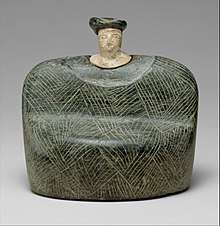
Regionalization Era
Regionalization Era begins in Anau IA with a pre-Chalcolithic phase also in Kopet Dag piedmont region from 4600 to 4000 BC, then Chalcolithic period developes from 4000 to 2800 BC in Namazga I-III, Ilgynly Depe, and Altyn Depe.[8] During this Copper Age, the population of the region grew. Archaeologist Vadim Mikhaĭlovich Masson, who led the South Turkmenistan Complex Archaeological Expedition from 1946, sees signs that people migrated to the region from central Iran at this time, bringing metallurgy and other innovations, but thinks that the newcomers soon blended with the Jeitun farmers.[12] (Vadim was the son of archaeologist Mikhail Masson, who already started work in this same area previously.) By contrast a re-excavation of Monjukli Depe in 2010 found a distinct break in settlement history between the late neolithic and early chalcolithic eras there.[13][14]
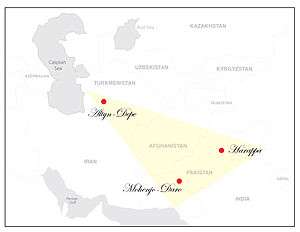
Major chalcolithic settlements sprang up at Kara-Depe and Namazga-Depe. In addition, there were smaller settlements at Anau, Dashlyji, and Yassy-depe. Settlements similar to the early level at Anau also appeared further east– in the ancient delta of the river Tedzen, the site of the Geoksiur Oasis. About 3500 BC, the cultural unity of the area split into two pottery styles: colourful in the west (Anau, Kara-Depe and Namazga-Depe) and more austere in the east at Altyn-Depe and the Geoksiur Oasis settlements. This may reflect the formation of two tribal groups. It seems that around 3000 BC, people from Geoksiur migrated into the Murghab delta (where small, scattered settlements appeared) and reached further east into the Zerafshan Valley in Transoxiana. In both areas pottery typical of Geoksiur was in use. In Transoxiana they settled at Sarazm near Pendjikent. To the south the foundation layers of Shahr-i Shōkhta on the bank of the Helmand river in south-eastern Iran contained pottery of the Altyn-Depe and Geoksiur type. Thus the farmers of Iran, Turkmenistan and Afghanistan were connected by a scattering of farming settlements.[12]
Late Regionalization Era
In the Early Bronze Age, at the end of Late Regionalization Era (2800 to 2400 BC),[8] the culture of the Kopet Dag oases and Altyn-Depe developed a proto-urban society. This corresponds to level IV at Namazga-Depe. Altyn-Depe was a major centre even then. Pottery was wheel-turned. Grapes were grown.
Integration Era
The height of this urban development was reached in the Middle Bronze Age also known as Integration Era, corresponding to Namazga-Depe level V (c. 2400-2000 BC).[8][12] Namazga Depe reaching c. 52 hectares and holding maybe 17–20,000 inhabitants, and Altyn Depe with its maximum size of c. 25 hectares and 7-10,000 inhabitants, were the two big cities in Kopet Dag piedmont.[15] It is this Bronze Age culture which has been given the BMAC name. Gonur Depe is the largest of all settlements in this period and is located at the delta of Murghab river in southern Turkmenistan (Margiana region) with an area of around 55 hectares. An almost elliptical fortified complex, known as Gonur North includes the so-called "Monumental Palace", other minor buildings, temples and ritual places, together with the "Royal Necropolis", and water reservoirs, all dating from around 2400 to 1900 BC.[16] In Bactria, Northern Afghanistan, the site Dashly 3 is regarded to be also from Middle Bronze Age period to Late Bronze Age (2300-1700 BCE), the old Dashly 3 complex, sometimes identified as a palace, is a fortified rectangular 88 m x 84 m compound. The square building had massive double outer walls and in the middle of each wall was a protruding salient composed of a T-shaped corridor flanked by two L-shaped corridors.[17]
Material culture
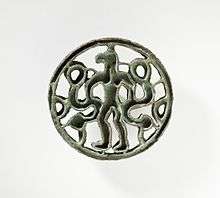
Agriculture and economy
The inhabitants of the BMAC were sedentary people who practised irrigation farming of wheat and barley. With their impressive material culture including monumental architecture, bronze tools, ceramics, and jewellery of semiprecious stones, the complex exhibits many of the hallmarks of civilisation. The complex can be compared to proto-urban settlements in the Helmand basin at Mundigak in western Afghanistan and Shahr-e Sukhteh in eastern Iran, or at Harappa and Mohenjo-daro in the Indus Valley.[18]
Models of two-wheeled carts from c. 3000 BC found at Altyn-Depe are the earliest evidence of wheeled transport in Central Asia, though model wheels have come from contexts possibly somewhat earlier. Judging by the type of harness, carts were initially pulled by oxen, or a bull. However camels were domesticated within the BMAC. A model of a cart drawn by a camel of c. 2200 BC was found at Altyn-Depe.[19]
Art
Fertility goddesses, named "Bactrian princesses", made from limestone, chlorite and clay reflect agrarian Bronze Age society, while the extensive corpus of metal objects point to a sophisticated tradition of metalworking.[20] Wearing large stylised dresses, as well as headdresses that merge with the hair, "Bactrian princesses" embody the ranking goddess, character of the central Asian mythology that plays a regulatory role, pacifying the untamed forces.
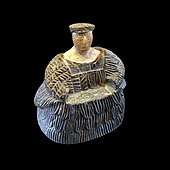 Female figurine of the "Bactrian princess" type; between 3rd millennium and 2nd millennium BC; chlorite mineral group (dress and headdresses) and limestone (face and neck); height: 17.3 cm, width: 16.1 cm; Louvre
Female figurine of the "Bactrian princess" type; between 3rd millennium and 2nd millennium BC; chlorite mineral group (dress and headdresses) and limestone (face and neck); height: 17.3 cm, width: 16.1 cm; Louvre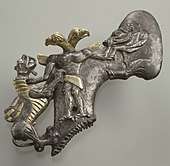 Axe with eagle-headed demon & animals; late 3rd millennium-early 2nd millennium BC; gilt silver; length: 15 cm; Metropolitan Museum of Art (New York City)
Axe with eagle-headed demon & animals; late 3rd millennium-early 2nd millennium BC; gilt silver; length: 15 cm; Metropolitan Museum of Art (New York City)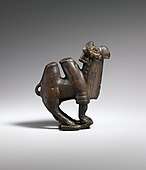 Camel figurine; late 3rd–early 2nd millennium BCE; copper alloy; 8.89 cm; Metropolitan Museum of Art
Camel figurine; late 3rd–early 2nd millennium BCE; copper alloy; 8.89 cm; Metropolitan Museum of Art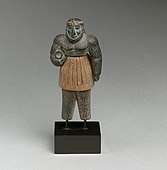
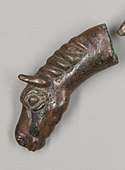 Axe head; late 3rd–early 2nd millennium BC; copper alloy; height: 2.8 cm, length: 7.2 cm, thickness: 1.8 cm, weight: 82.5 g; Metropolitan Museum of Art
Axe head; late 3rd–early 2nd millennium BC; copper alloy; height: 2.8 cm, length: 7.2 cm, thickness: 1.8 cm, weight: 82.5 g; Metropolitan Museum of Art.jpg) Female figurine of the "Bactrian princess" type; between 3rd millennium and 2nd millennium BC; grey chlorite (dress and headdresses) and calcite (face); Barbier-Mueller Museum (Geneva, Switzerland)
Female figurine of the "Bactrian princess" type; between 3rd millennium and 2nd millennium BC; grey chlorite (dress and headdresses) and calcite (face); Barbier-Mueller Museum (Geneva, Switzerland)_1.jpg) Female figurine of the "Bactrian princess" type; between 3rd millennium and 2nd millennium BC; grey chlorite (dress and headdresses) and calcite (face); Barbier-Mueller Museum
Female figurine of the "Bactrian princess" type; between 3rd millennium and 2nd millennium BC; grey chlorite (dress and headdresses) and calcite (face); Barbier-Mueller Museum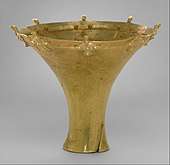 Beaker with birds on the rim; late 3rd–early 2nd millennium BC; electrum; height: 12 cm, width: 13.3 cm, depth: 4.5 cm; Metropolitan Museum of Art
Beaker with birds on the rim; late 3rd–early 2nd millennium BC; electrum; height: 12 cm, width: 13.3 cm, depth: 4.5 cm; Metropolitan Museum of Art.jpg) Handled weight; late 3rd–early 2nd millennium BC; chlorite; 25.08 x 19.69 x 4.45 cm; Los Angeles County Museum of Art (USA)
Handled weight; late 3rd–early 2nd millennium BC; chlorite; 25.08 x 19.69 x 4.45 cm; Los Angeles County Museum of Art (USA).jpg) Female figurine of the "Bactrian princess" type; 2500-1500; chlorite (dress and headdresses) and limestone (head, hands and a leg); height: 13.33 cm; Los Angeles County Museum of Art (USA)
Female figurine of the "Bactrian princess" type; 2500-1500; chlorite (dress and headdresses) and limestone (head, hands and a leg); height: 13.33 cm; Los Angeles County Museum of Art (USA)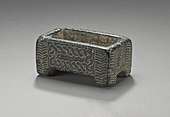 Vessel with gilloche pattern; 2000-1500; chlorite; 3.33 x 6.67 x 3.81 cm; Los Angeles County Museum of Art
Vessel with gilloche pattern; 2000-1500; chlorite; 3.33 x 6.67 x 3.81 cm; Los Angeles County Museum of Art- Female figurine of the "Bactrian princess" type; 2nd millennium BC; chlorite and calcite; Louvre
Architecture
Sarianidi regards Gonur as the "capital" of the complex in Margiana throughout the Bronze Age. The palace of north Gonur measures 150 metres by 140 metres, the temple at Togolok 140 metres by 100 metres, the fort at Kelleli 3 125 metres by 125 metres, and the house of a local ruler at Adji Kui 25 metres by 25 metres. Each of these formidable structures has been extensively excavated. While they all have impressive fortification walls, gates, and buttresses, it is not always clear why one structure is identified as a temple and another as a palace.[21] Mallory points out that the BMAC fortified settlements such as Gonur and Togolok resemble the qila, the type of fort known in this region in the historical period. They may be circular or rectangular and have up to three encircling walls. Within the forts are residential quarters, workshops and temples.[22]
The people of the BMAC culture were very proficient at working in a variety of metals including bronze, copper, silver, and gold. This is attested through the many metal artefacts found throughout the sites.
Extensive irrigation systems have been discovered at the Geoksiur Oasis.[12]
Writing
The discovery of a single tiny stone seal (known as the "Anau seal") with geometric markings from the BMAC site at Anau in Turkmenistan in 2000 led some to claim that the Bactria-Margiana complex had also developed writing, and thus may indeed be considered a literate civilisation. It bears five markings which are similar to Chinese "small seal" characters. The only match to the Anau seal is a small jet seal of almost identical shape from Niyä (near modern Minfeng) along the southern Silk Road in Xinjiang, originally thought to be from the Western Han dynasty but now thought to date to 700 BC.[23]
Interactions with other cultures
BMAC materials have been found in the Indus Valley Civilisation, on the Iranian Plateau, and in the Persian Gulf.[21] Finds within BMAC sites provide further evidence of trade and cultural contacts. They include an Elamite-type cylinder seal and a Harappan seal stamped with an elephant and Indus script found at Gonur-depe.[24] The relationship between Altyn-Depe and the Indus Valley seems to have been particularly strong. Among the finds there were two Harappan seals and ivory objects. The Harappan settlement of Shortugai in Northern Afghanistan on the banks of the Amu Darya probably served as a trading station.[12]
There is evidence of sustained contact between the BMAC and the Eurasian steppes to the north, intensifying c. 2000 BC. In the delta of the Amu Darya where it reaches the Aral Sea, its waters were channelled for irrigation agriculture by people whose remains resemble those of the nomads of the Andronovo culture. This is interpreted as nomads settling down to agriculture, after contact with the BMAC, known as the Tazabagyab culture.[25] About 1900 BC, the walled BMAC centres decreased sharply in size. Each oasis developed its own types of pottery and other objects. Also pottery of the Tazabagyab-Andronovo culture to the north appeared widely in the Bactrian and Margian countryside. Many BMAC strongholds continued to be occupied and Tazabagyab-Andronovo coarse incised pottery occurs within them (along with the previous BMAC pottery) as well as in pastoral camps outside the mudbrick walls. In the highlands above the Bactrian oases in Tajikistan, kurgan cemeteries of the Vaksh and Bishkent type appeared with pottery that mixed elements of the late BMAC and Tazabagyab-Andronovo traditions.[26] In southern Bactrian sites like Sappali Tepe too, increasing links with the Andronovo culture are seen. During the period 1700 - 1500 BCE, metal artifacts from Sappali Tepe derive from the Tazabagyab-Andronovo culture.[27]
Relationship with Indo-Iranians
The Bactria–Margiana complex has attracted attention as a candidate for those looking for the material counterparts to the Indo-Iranians (Aryans), a major linguistic branch that split off from the Proto-Indo-Europeans. Sarianidi himself advocates identifying the complex as Indo-Iranian, describing it as the result of a migration from southwestern Iran. Bactria–Margiana material has been found at Susa, Shahdad, and Tepe Yahya in Iran, but Lamberg-Karlovsky does not see this as evidence that the complex originated in southeastern Iran. "The limited materials of this complex are intrusive in each of the sites on the Iranian Plateau as they are in sites of the Arabian peninsula."[21]
A significant section of the archaeologists are more inclined to see the culture as begun by farmers in the Near Eastern Neolithic tradition, but infiltrated by Indo-Iranian speakers from the Andronovo culture in its late phase, creating a hybrid. In this perspective, Proto-Indo-Aryan developed within the composite culture before moving south into the Indian subcontinent.[26]
The Andronovo, BMAC and Yaz cultures have often been associated with Indo-Iranian migrations. As James P. Mallory phrased it:
It has become increasingly clear that if one wishes to argue for Indo-Iranian migrations from the steppe lands south into the historical seats of the Iranians and Indo-Aryans that these steppe cultures were transformed as they passed through a membrane of Central Asian urbanism. The fact that typical steppe wares are found on BMAC sites and that intrusive BMAC material is subsequently found further to the south in Iran, Afghanistan, Nepal, India and Pakistan, may suggest then the subsequent movement of Indo-Iranian-speakers after they had adopted the culture of the BMAC.[28]
According to recent studies[29] BMAC was not a primary contributor to later South-Asian genetics.
Possible evidence for a BMAC substratum in Indo-Iranian
As argued by Michael Witzel[30] and Alexander Lubotsky,[31] there is a proposed substratum in Proto-Indo-Iranian which can be plausibly identified with the original language of the BMAC. Moreover, Lubotsky points out a larger number of words apparently borrowed from the same language, which are only attested in Indo-Aryan and therefore evidence of a substratum in Vedic Sanskrit. He explains this by proposing that Indo-Aryan speakers probably formed the vanguard of the movement into south-central Asia and many of the BMAC loanwords which entered Iranian may have been mediated through Indo-Aryan.[31]:306 Michael Witzel points out that the borrowed vocabulary includes words from agriculture, village and town life, flora and fauna, ritual and religion, so providing evidence for the acculturation of Indo-Iranian speakers into the world of urban civilisation.[30]
Genetics
In 2018, Narasimhan and co-authors analyzed BMAC skeletons from the Bronze Age sites of Bustan, Dzharkutan, Gonur Tepe, and Sapalli Tepe. The male specimens belonged to haplogroup E1b1a (1/18), E1b1b (1/18), G (2/18), J* (2/18), J1 (1/18), J2 (4/18), L (2/18), R* (1/18), R1b (1/18), R2 (2/18), and T (1/18).[29]
A follow-up study by Narasimhan and co-authors (2019) suggested the primary BMAC population largely derived from preceding local Copper Age peoples who were in turn related to prehistoric farmers from the Iranian plateau and to a lesser extent early Anatolian farmers and hunter-gatherers from Western Siberia, and they did not contribute substantially to later populations further south in the Indus Valley.[32]
Sites
In Afghanistan:
- Dashli, Jowzjan province
- Khush Tepe (Fullol)
In Turkmenistan:
- Altyndepe
- Gonur Tepe
- Jeitun
- Namazga-Tepe
- Togolok 21
- Ulug Depe
In Uzbekistan:
- Ayaz Kala
- Djarkutan
- Koi Krylgan Kala
- Sappali tepe
- Toprak Kala
See also
| Wikimedia Commons has media related to Bactria-Margiana Archaeological Complex. |
| Wikiquote has quotations related to: Bactria–Margiana Archaeological Complex |
References
- Vidale, Massimo, 2017. Treasures from the Oxus, I.B. Tauris, pp. 9, 18, & Table 1,
- See Sarianidi, V. I. 1976. "Issledovanija pamjatnikov Dashlyiskogo Oazisa," in Drevnii Baktria, vol. 1. Moscow: Akademia Nauk.
- John Noble Wilford, (May 13, 2001). "In Ruin, Symbols on a Stone Hint at a Lost Asian Culture", in New York Times.
- Kurbanov, Aydogdy, (14 September 2018). "A brief history of archaeological research in Turkmenistan from the beginning of the 20th century until the present", in ArchéOrient.
- Atagarryev E., and Berdiev O.K., (1970). "The Archaeological Exploration of Turkmenistan in the Year of Soviet Power", East and West 20, pp. 285-306.
- Masson, V.M., and V.I. Sarianidi, (1972). Central Asia: Turkmenia before the Achaemenids, London, Thames and Hudson.
- Levine, Louis D., (1975). "Review to: Masson, V. M., and V. I. Sarianidi. Central Asia: Turkmenia before the Achaemenids (1972)" , in The American Historical Review, Volume 80, Issue 2, April 1975, p. 375.
- Vidale, Massimo, (2017). Treasures from the Oxus, p. 9, Table 1.
- Harris, D. R.; Gosden, C.; Charles, M. P. (1996). "Jeitun: Recent excavations at an early Neolithic site in Southern Turkmenistan". Proceedings of the Prehistoric Society. 62: 423–442. doi:10.1017/S0079497X00002863.
- Miller, Naomi F. (1999). "Agricultural development in western Central Asia in the Chalcolithic and Bronze Ages". Vegetation History and Archaeobotany. 8: 13–19. doi:10.1007/BF02042837.
- Kohl 2007, pp. 189–190.
- Masson, V. M. (1992). "The Bronze Age in Khorasan and Transoxiana". In Dani, A. H.; Masson, Vadim Mikhaĭlovich (eds.). History of civilizations of Central Asia. volume 1: The dawn of civilization: earliest times to 700 BCE. ISBN 92-3-102719-0.
- Reinhard Bernbeck et al., "A-II Spatial Effects of Technological Innovations and Changing Ways of Life," in Friederike Fless, Gerd Graßhoff, Michael Meyer (eds.), Reports of the Research Groups at the Topoi Plenary Session 2010, eTopoi: Journal for Ancient Studies, Special Volume 1 (2011).
- Monjukli Depe artefacts (in German).
- Vidale, Massimo, (2017). Treasures from the Oxus, pp. 10, 18.
- Frenez, Dennys, (2018). "Manufacturing and trade of Asian elephant ivory in Bronze Age Middle Asia: Evidence from Gonur Depe (Margiana, Turkmenistan)" in Archaeological Research in Asia 15, p. 15.
- K.E. Eduljee, "Dashly",(2005).
- Kohl 2007, pp. 186–187.
- Kirtcho, L. B. (2009). "The earliest wheeled transport in Southwestern Central Asia: new finds from Alteyn-Depe". Archaeology Ethnology and Anthropology of Eurasia. 37 (1): 25–33. doi:10.1016/j.aeae.2009.05.003.
- Fortenberry, Diane (2017). THE ART MUSEUM. Phaidon. p. 66. ISBN 978-0-7148-7502-6.
- Lamberg-Karlovsky, C. C. (2002). "Archaeology and Language: The Indo-Iranians". Current Anthropology. 43 (1): 63–88. doi:10.1086/324130.
- Mallory & Adams 1997, p. 72.
- Colarusso, John (2002). Remarks on the Anau and Niyä Seals. Sino-Platonic Papers. 124. pp. 35–47.
- Kohl 2007, pp. 196–199.
- Kohl 2007, Chapter 5.
- David Anthony, The Horse, the Wheel and Language (2007), pp.452–56.
- Kaniuth, Kai (2007). "The metallurgy of the Late Bronze Age Sappali Culture (southern Uzbekistan) and its implications for the 'tin question'". Iranica Antiqua. 42: 23–40. doi:10.2143/IA.42.0.2017869.
- Mallory & Adams 1997, p. 73.
- Narasimhan, Vagheesh M.; et al. (2018-03-31). "The Genomic Formation of South and Central Asia". bioRxiv: 292581. doi:10.1101/292581.
- Witzel, Michael (2003). Linguistic Evidence for Cultural Exchange in Prehistoric Western Central Asia. Sino-Platonic Papers. 129.
- Lubotsky, Alexander (2001). "The Indo-Iranian substratum". In Carpelan, Christian (ed.). Early Contacts between Uralic and Indo-European: Linguistic and Archaeological considerations. Papers presented at an international symposium held at the Tvärminne Research Station of the University of Helsinki 8–10 January 1999. Helsinki, Finland: Finno-Ugrian Society. pp. 301–317.
- Narasimhan, Vagheesh M.; et al. (2019). "The formation of human populations in South and Central Asia". Science. 365 (6457): eaat7487. doi:10.1126/science.aat7487. PMC 6822619. PMID 31488661.
Sources
- Francfort, H.P. (1991), "Note on some Bronze Age Petroglyphs of Upper Indus and Central Asia", Pakistan Archaeology, 26: 125–135
- Francfort, H.P. (1994), "The central Asian Dimension of the Symbolic System in Bactria and Margia", Antiquity, 28 (259), pp. 406–418
- Kohl, Philip L. (2007). The Making of Bronze Age Eurasia. Cambridge Universy Press. ISBN 978-1139461993.CS1 maint: ref=harv (link)
- Mallory, J. P.; Adams, D. Q. (1997). "BMAC". Encyclopedia of Indo-European Culture. London: Fitzroy Dearborn. ISBN 1-884964-98-2.CS1 maint: ref=harv (link)
- Parpola, Asko (2015). The Roots of Hinduism: The Early Aryans and the Indus Civilization. Oxford University Press Incorporated. ISBN 978-0190226923.CS1 maint: ref=harv (link)
Further reading
- Edwin Bryant (2001). The Quest for the Origins of Vedic Culture: The Indo-Aryan Migration Debate. Oxford University Press. ISBN 0-19-516947-6.
- CNRS, L'archéologie de la Bactriane ancienne, actes du colloque Franco-soviétique n° 20. Paris: Editions du Centre National de la Recherche Scientifique, 1985, ISBN 2-222-03514-7
- Fussman, G.; et al. (2005). Aryas, Aryens et Iraniens en Asie Centrale. Paris: de Boccard. ISBN 2-86803-072-6.
- Lubotsky, A. (2001). "Indo-Iranian substratum" (PDF). In Carpelan, Christian (ed.). Early Contacts between Uralic and Indo-European. Helsinki: Suomalais-Ugrilainen Seura. ISBN 952-5150-59-3. Archived from the original (PDF) on 2008-04-11.
- Sarianidi, V. I. (1994). "Preface". In Hiebert, F. T. (ed.). Origins of the Bronze Age Oasis Civilization of Central Asia. Cambridge: Harvard University Press. ISBN 0-87365-545-1.
- Sarianidi, V. I. (1995). "Soviet Excavations in Bactria: The Bronze Age". In Ligabue, G.; Salvatori, S. (eds.). Bactria: An ancient oasis civilization from the sands of Afghanistan. Venice: Erizzo. ISBN 88-7077-025-7.
- Forizs, L. (2016, 2003) Apāṁ Napāt, Dīrghatamas and Construction of the Brick Altar. Analysis of RV 1.143 in the homepage of Laszlo Forizs